Arden Stern
I first saw Adrian Chooye painting on Addis Ababa Road, one of the main roads east of downtown Lusaka, Zambia, and plied him with Fanta to lubricate a discussion about the sign he was painting there. He offered to take me around the city to photograph some of his work the following day. It was to be the first of four walks we took together through the city, spanning from the wealthy residential neighborhoods to the dilapidated northern townships of the Lusaka sprawl.
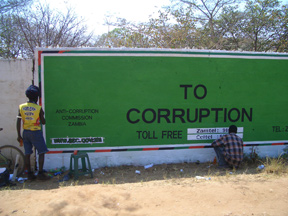 In process
In process Finished
Finished
What became immediately apparent was that Adrian and I shared the somewhat inconvenient trait of awkward reticence, and we struggled for conversation during the initial hour of the walk. “Do you have an email address?” I asked him, hoping that he, like me, might be more generous with text than speech.
Adrian held out his hand and imitated pressing a button. “I don’t even know how to turn on a computer,” he said.
This disclosure was a pivot in my research on Zambian advertising signage, collapsing the edges of something I had loosely identified as “difference” in graphic design practice into a deepened division among designers themselves. On Great East Road, which adjoins Addis Ababa, more of Adrian’s signs were on segments of a cinderblock wall that hemmed a row of sizable, digitally printed billboards. Faced with such a tableau, what became compelling about Lusaka’s street graphics was no longer the conceptual framework behind them—digitally printed signs and painted ones, after all, often featured similar or duplicate brand imagery—but the coexistence of such variant methods of and approaches to producing them.
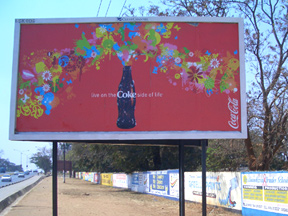
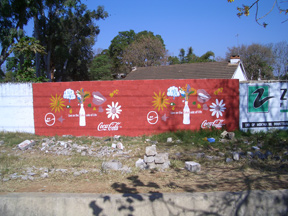
In an interview with two young designers at the Lusaka branch of G. Rutherford, a digital sign printing company, it became clear that this coexistence is not without tension. When I told Kelvin Kamanga that I had been researching sign painting, he looked slightly embarrassed. “It’s quite backwards, isn’t it?” he responded, and led me into his office to show me the personal projects he works on in Photoshop when business is slow. According to Kamanga and his colleague, Emmanuel Kongolo, computer-aided graphic design is a relatively new profession in the Zambian business sphere. Both Kamanga and Kongolo attended Evelyn Hone College, only blocks away from the G. Rutherford office, where they learned to use Photoshop and other design programs. Such an education, costing millions of kwacha (thousands of US dollars), shuts out the vast majority of sign painters. Painters are often self-taught, or mentored by more experienced painters, and they use relatively inexpensive equipment (paint stored in used plastic bottles, a few brushes and plenty of pencils).
Despite such limitations, the sign painting profession itself is far from backwards. Judging by the sporadic signatures and phone numbers on the painted signs, it became clear that many sign painters not only claim a certain degree of authorship, but also use their existing work to market themselves for future jobs. The first interview I had with a painter was simply a matter of calling the number I saw on the bottom edge of one sign near the Agricultural Showgrounds on Great East Road.
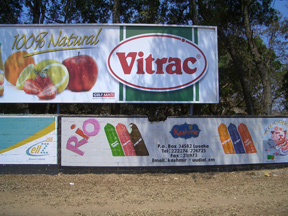

After scheduling the interview by phone, I took a taxi to the car wash where the veteran sign painter, Emanuel Kazembe, had based his small sign painting company. Upon my arrival at the car wash, he greeted me warmly and, without prompting, began telling the story of his career, from the 1970s to the present, as oratory. “I cannot say that I am the best sign painter in Lusaka,” he said. “I am, perhaps, the second best.” Despite contradictions in his narrative and lapses into grandiloquence, Kazembe’s rhetorical force would have been compelling enough to sell me just about anything; unused to the artfulness of a skilled salesman, or to face-to-face market encounters in general, I found myself at the mercy of someone who wanted from me perhaps more than I wanted from him. Convinced that the acquisition of digital printing equipment was the only way his business could survive, Kazembe saw that my interest in him as a subject of research could pave the way to the funding he required. I realized quickly that his agreement to an interview had been in the service of this possibility, and that his performance of both friendliness and expert knowledge were designed to present him as a worthy investment. As I left the car wash I felt guilty that I couldn’t offer anything useful in return for his masterful performance. Indeed, my own stinginess mirrored that of the companies who pay a sign painter only a fraction of what they would pay for a printed billboard.
Three apprentice painters, younger than Mr. Kazembe by decades (though he did not give his age, the dates he gave me for his secondary school education and career led me to believe he was in his mid 40s), worked on sign boards propped against the side of a shack in a sort of assembly line. One man painted a base coat, another traced stencils. Both Kazembe and Adrian, though frequently working from cheap 8.5×11 printouts of sign images, prided themselves on their abilities to draw and produce text freehand. This pride suggested that, perhaps among more experienced painters, a reliance on even the most basic technology betrays a lack of technical skill. I interpreted this not merely as a signal that the encroaching digital advertising age had compelled sign painters to distinguish themselves from that technology, but that the profession of sign painting itself had been subject to decades of conventions, rules, and hierarchies beyond its coexistence with mechanically reproduced graphics. Kazembe’s performative professional persona suggested that one of the conventions of sign painting went beyond the images themselves, encompassing the self-produced image of the painter himself as an artist and public figure.
After accompanying Adrian into his own neighborhood, a compound north of downtown Lusaka, I discovered that the bulk of his work was not in the commercial areas of town, but rather within a mile or two of his home. Furthermore, it became evident that his status as an esteemed local artist had afforded him greater control over the signs he produced for the bars, shops, and shacks in the compounds. Here, it was not plausible to work from a printed prototype. Instead, he took the given information—the name of the establishment, images of its contents, and relevant logos and brand names—and used it as a platform upon which to display a unique, recognizable style combined with Rastafarian and local “tribal” imagery. Adrian identified himself to me as belonging to the Tonga tribe, and often painted baboons, representing Bemba-speakers, and rats, representing speakers of Chichewa (two commonly spoken local languages), into his signs. The individual and the local were, in Adrian’s work, contingent elements of his artistic persona. His waist-length dreadlocks, along with the distinctive countenance—downcast eyes, demure expression—he affected in real life as much as in paint, made self-portraits all the more valuable as promotional tools. Adrian was an infinitely recognizable character in the compounds both in life and in paint, and these two Adrians, in tandem, confirmed and maintained his reputation.
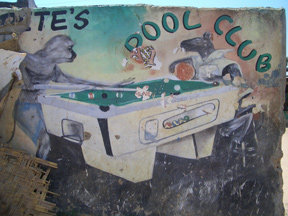

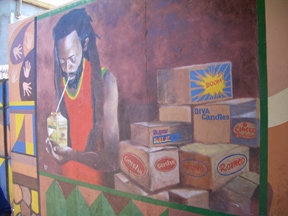 Adrian Chooye’s work
Adrian Chooye’s work
Everywhere Adrian and I walked together, he was acknowledged; he knew plenty of people, particularly in the compounds, and, was respectfully saluted by those who did not know him, since Adrian’s Rastafarianism, as much as my incongruous whiteness, seemed to invite comments from passersby.
In a place where most interactions occur face to face, though increasingly by phone, it seems that a sign painter’s best chance at finding a job is to be recognizable: in other words, to let his paintings and his presence work for him. I only saw one sign in which Adrian had painted his phone number. The rest were simply signed. Adrian told me that he found work through friends, through acquaintances, and occasionally after being accosted by interested parties while painting (much as I had done, to alternate ends). The networks he existed in were personal rather than technologically mediated, so his performance of “artist” was central to his success within them.
Success, according to Adrian himself, was survival. He told me that his dependence on continuous jobs was such that if a previous client was slow to pay him for finished work, he might not be able to afford paint for the next job. This is the less glamorous side of face to face networking: “contracts” with clients are predominantly verbal, giving the sign painter little recourse if money shows up in smaller amounts than expected, late, or not at all. Once again, I witnessed the division between designers manifested by Adrian’s dearth of technological savvy, along with his wealth of personal style and painting experience.
The division, however, doesn’t lie on a timeline that places sign painters in the realm of the old and digital graphic designers in the new. Though digital advertising design is undoubtedly a more recent addition to the visual landscape of Lusaka, the continued prevalence of the painted sign suggests that inexpensive skilled labor continues to be the dominant option for advertising. This suggests more about the economic situation of most businesses in Zambia, as well as convention and habit: while the larger South African corporations can easily import advertising along with their products, Zambian companies, even those with the financial ability to incorporate printed advertising in their marketing, still employ sign painters. An equally significant division between graphic artists, then, is that between the sign painters themselves. As long as painted signage continues to predominate, Zambian sign painters will continue to adapt to the environment, acquiring not only the technical skills but also the marketing skills to compete against one another.
For me to understand another aspect of the sign painter’s foothold in Zambian visual culture, I had to see a public service sign that Adrian had completed only a few weeks before we first met.
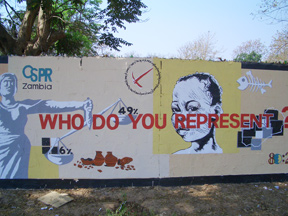
According to him, the client had provided text but had not provided the images, and he had been afforded a great deal of control over the accompanying images. Given so much freedom, Adrian could both ask and answer the question passed on to him as words (Who do you represent?) with images unique to his experience, to his Zambia—so it was a question that he, more than any viewer, could answer best.
Arden Stern is a third-year graduate student in Visual Studies at the University of California, Irvine. Her work focuses on the forgotten and overlooked histories of graphic design and spans from the history of italics to the history of sign painting in Africa.











Leave a Reply
You must be logged in to post a comment.